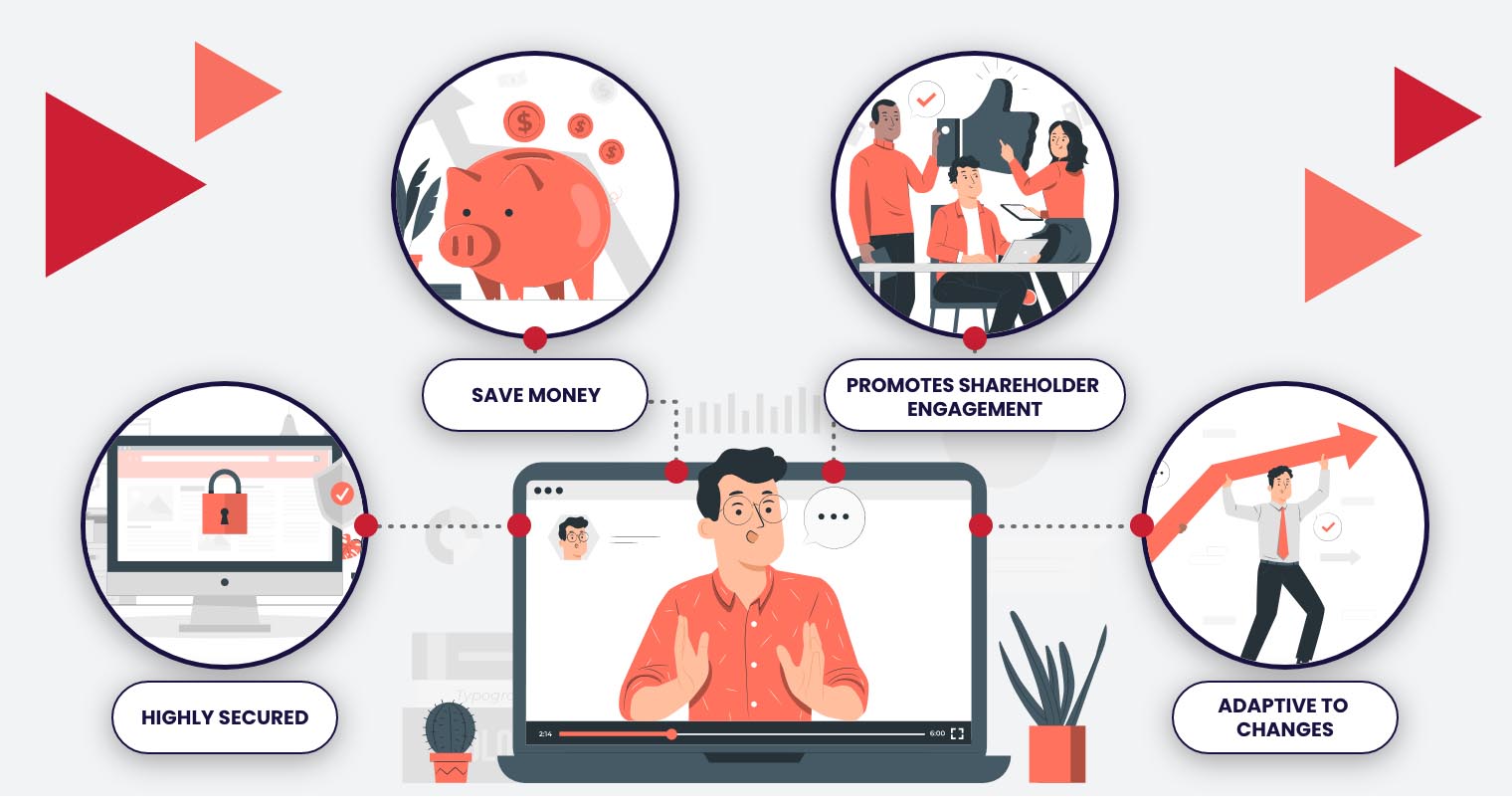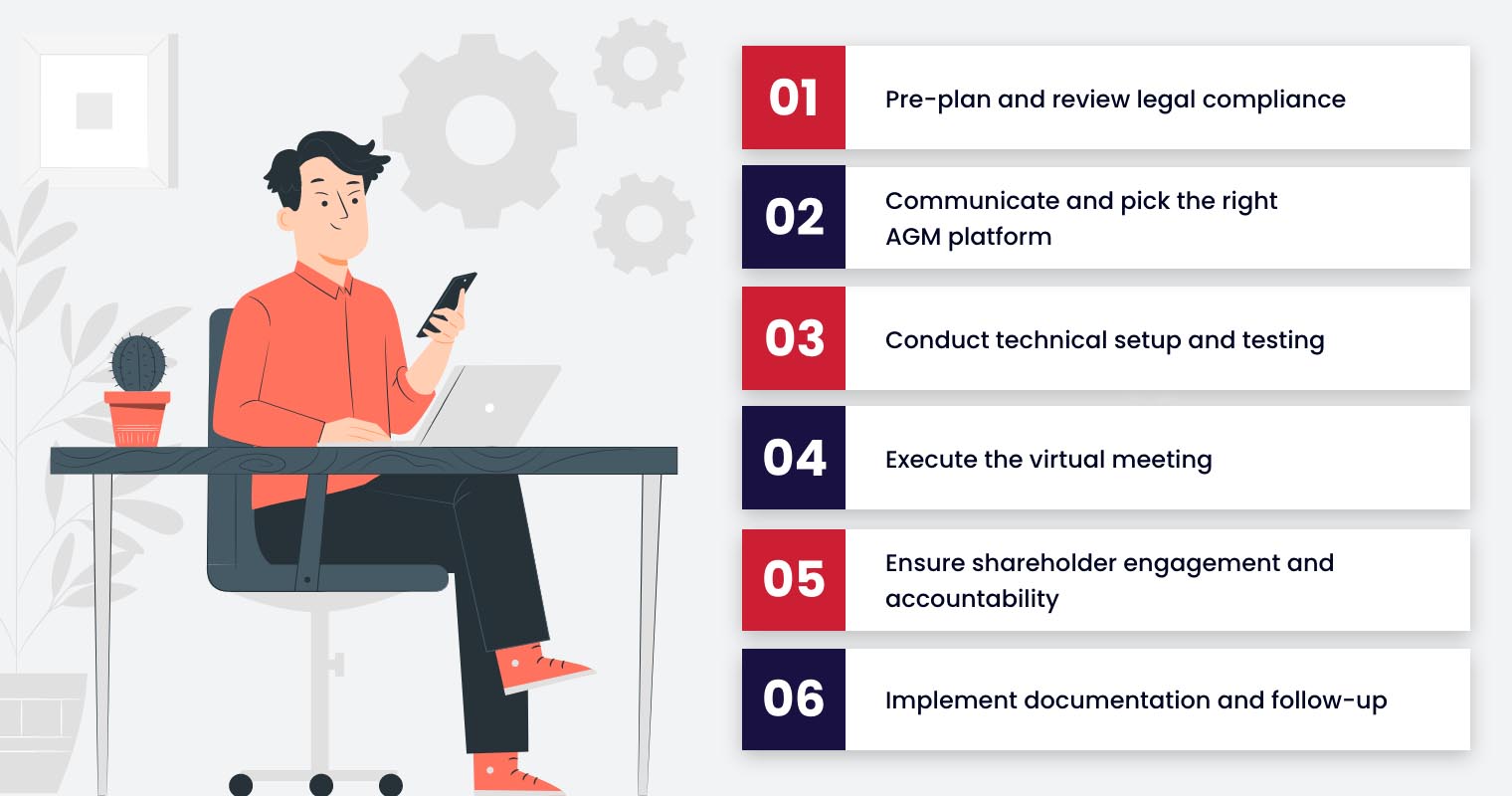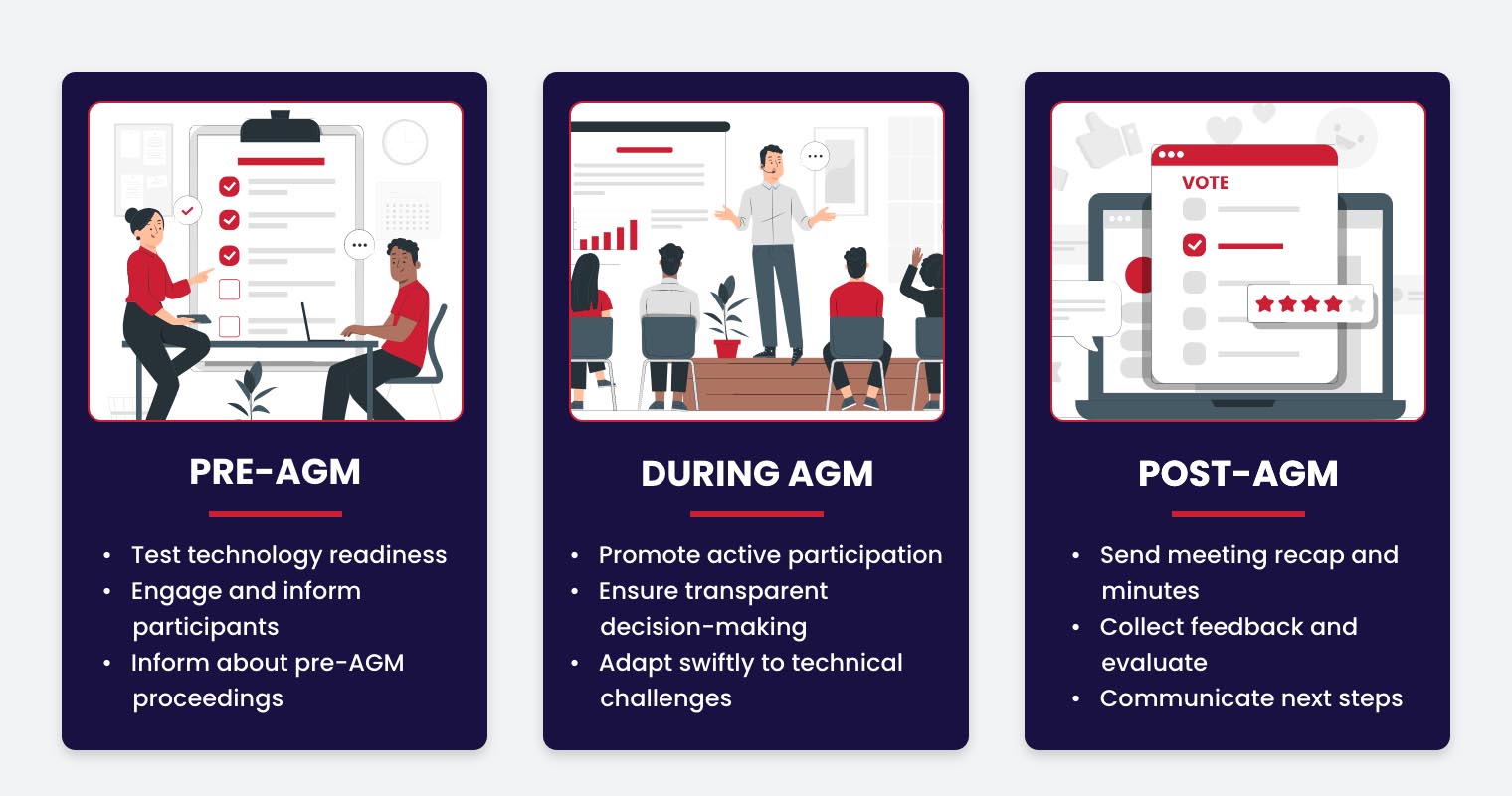Traditionally, annual general meetings (AGMs) were synonymous with physical presence. However, the contemporary global crisis has ushered AGMs into the digital environment. What exactly are online AGMs, and how do they differ from traditional in-person shareholder gatherings?
What are online AGMs?
An annual general meeting (AGM), or annual shareholder meeting, is a mandatory yearly gathering of a company’s shareholders. At an AGM, shareholders vote on critical company matters like board appointments, compensation, and dividends, and engage in discussions and queries. Company directors present company-related information, such as annual performance, goals, and strategy.
An online or virtual AGM is the equivalent of an in-person shareholder meeting but occurs entirely online. All the discussions, elections, resolutions, and questions are conducted virtually through the Internet.
Such a format lets shareholders actively take part in AGMs, giving them the same set of privileges and transparency as in-person meetings. The online AGM’s structure and agenda remain unaltered, with proceedings recorded for legal compliance.
Likewise, shareholder meetings can adopt a hybrid format, accommodating both physical and remote attendance. This approach fosters inclusivity and engagement across diverse demographics. In essence, online AGMs transpire purely virtually, while hybrid AGMs blend physical and virtual participation.
Virtual and hybrid AGMs are categorized as electronic annual general meetings. These meetings utilize electronic communication tools like video conferencing apps or dedicated platforms. These digital shifts redefine shareholder interaction and engagement, shaping the future of AGMs.
Key Differences of Physical, Hybrid, Virtual, and Webcast-Only Meetings
Physical, hybrid, virtual, and webcast-only meetings are different formats for conducting gatherings or events. To understand how these meeting formats work and how distinctive they are from each other, here are the key differences to take note of.
1. Format and Interaction
- Physical Meetings — These are in-person gatherings at a specific location, allowing direct interaction. It is usually preferable for smaller groups and events with participants present physically.
- Hybrid Meetings — These combine in-person and virtual attendance, facilitating collaboration between both groups. Participants can also choose to join in person or remotely.
- Virtual Meetings — Often referred to as entirely online gatherings with remote participants from various locations. Participants connect through video conferencing or virtual meeting software.
- Webcast-Only Meetings — They are online meetings with live streams, but no direct interaction. These one-way broadcasts are ideal for large events or presentations with a wide audience.
2. Time, Scheduling, and Flexibility
- Physical Meetings — Such formats often require specific dates and locations and are less flexible in scheduling. With that in mind, participants will need to plan for travel and accommodation ahead of time.
- Hybrid Meetings — Due to their virtual aspects, participants have the flexibility to choose to attend in-person or remotely, whichever is more convenient for them.
- Virtual Meetings — These meetings provide more flexibility as attendees join remotely. There’s no need for travel, which enables participation from any location.
- Webcast-Only Meetings — This format typically comes in set schedules for the live stream. Participants can access the content or presentation at a designated time but cannot interact.
3. Technology Requirements
- Physical Meetings — These meetings offer minimal reliance on technology for communication and collaboration.
- Hybrid Meetings — The hybrid format requires a stable internet connection, suitable devices, and a meeting solution for remote participants.
- Virtual Meetings — Considering all participants will attend the meeting virtually, a strong internet connection and a versatile meeting platform that can work on multiple devices.
- Webcast-Only Meetings — Similar to hybrid and virtual requirements, this format needs internet access and a meeting tool to watch the live stream.
4. Engagement and Networking Opportunities
- Physical Meetings — Traditionally, physical board meetings are perceived to facilitate more engagement and networking with direct interactions.
- Hybrid Meetings — The hybrid format offers amazing engagement opportunities for both in-person and remote participants. However, compared to physical meetings, networking opportunities may be more limited for remote attendees.
- Virtual Meetings — This format may have challenges in maintaining active participation and networking. To promote engagement, using various collaboration tools is recommended to promote engagement.
- Webcast-Only Meetings — As this is a one-way broadcast, there are limited engagement and networking opportunities for participants.
5. Accessibility and Environmental Impact
- Physical Meetings — Considering physical attendance is required, it is less accessible for individuals with mobility or location constraints. Physical meetings also generally have a higher carbon footprint due to travel and venue requirements.
- Hybrid Meetings — The hybrid format offers increased accessibility for remote participants, promoting inclusivity. Its environmental impact varies based on the number of physical attendees.
- Virtual Meetings — Remote participants have the convenience to access the meeting regardless of their location. This format is also more environmentally friendly compared to physical and hybrid meetings.
- Webcast-Only Meetings — Webcast-only format also provides great accessibility for a broader audience as anyone with internet access can join. It is also considered environmentally friendly due to reduced travel and venue requirements.
Choosing the most suitable meeting format depends on factors such as the event’s nature, the number of participants, participants’ preferences, logistical considerations, and the desired level of engagement and interaction.
The Benefits of Shifting to Online AGMs

With the rise of advancements in executing AGMs, what benefits can companies and organizations expect with the switch to online annual general meetings?
1. They are secured
The stereotype with online platforms is that anything put up digitally is vulnerable to attacks and intrusion. That is not the case for most eAGM platforms. Remote technologies used for conducting virtual meetings must provide high-level security for attendees, including a secure network connection.
Because the main objective during AGMs is voting on critical company decisions, online AGM platforms employ robust security measures. Strict authentication and access control rules keep unauthorized third parties from obtaining access to sensitive data and interfering with proceedings. Online and hybrid AGMs are monitored throughout to prevent security breaches during the meeting.
2. They can help save money
Hosting virtual shareholder meetings reduces much of the spending observed in physical meetings. In an in-person AGM, logistical hassles incur expenses such as renting a venue and food catering. Adopting a virtual AGM can help in lessening such costs.
No need for registration desks as attendees can register through QR code scanning, minimizing costs in sanitation as well. Participants can also cast votes through their mobile devices, cutting expenses on printed voting slips, physical ballots, and document distribution. With online AGMs, travel and accommodation costs will be lessened as shareholders can take part actively without leaving their homes.
3. They promote shareholder engagement
Poor attendance and engagement during online AGMs are two of the biggest adoption fears for a virtual shareholder meeting. However, research suggests that the number of virtual shareholder meetings continue to grow, rising to approximately 69% in 2022.
With features that allow participants to ask questions without broadcast delay, eAGMs can ensure increased engagement of shareholders. Furthermore, live voting can aid in elevating the transparency of shareholders as results are instantly tabulated.
4. They help companies adapt to rapid changes
In times when global travel restrictions are enforced, virtual annual meetings are a safe alternative to in-person meetings. Online AGMs became the new normal for companies that want to maintain operations. Hybrid AGMs can aid in seamlessly transitioning the company’s general meeting proceedings from entirely physical to virtual.
However, organizations have to perform an in-depth analysis of which meeting format can help them achieve goals safely and effectively. The decision between meeting formats depends on the complexity of the agenda and the number of attendees eligible to vote.
Essential Roles in Conducting a Seamless Virtual AGM
Conducting a successful virtual annual general meeting requires coordination and collaboration among various individuals who play specific roles to ensure the smooth flow of the event. Find out about these roles below.
1. Attendee Supervisor
The Attendee Supervisor is responsible for managing the participants who join the virtual AGM. Their role includes:
- Assisting attendees with technical issues during the event.
- Providing guidance on accessing the virtual platform, joining the meeting, and troubleshooting common problems.
- Addressing questions from attendees related to the event logistics, schedule, and interaction.
2. Presenter
The Presenter is a key individual responsible for delivering presentations, reports, and information to the AGM participants. This role is often taken by the Chairperson, Board Director, or a designated expert. The presenter’s responsibilities involve:
- Preparing and organizing content to be presented during the meeting.
- Delivering the presentations in a clear and engaging manner.
- Sharing visuals, documents, and slides to support the presentation.
- Answering questions or clarifying points raised by the attendees.
3. Moderator
The Moderator, often a seasoned facilitator or a board secretary, oversees the overall flow and interaction during the virtual AGM. Their responsibilities include:
- Introducing speakers and presenters.
- Managing the Q&A sessions by selecting and forwarding relevant questions to the presenters.
- Ensuring that discussions remain focused and within the allocated time.
- Monitoring the chat or messaging system for participant queries and comments.
4. Vote Supervisor
The Vote Supervisor manages the voting process for resolutions, decisions, or elections that take place during the AGM. Their role encompasses:
- Explaining the voting procedure to participants.
- Distributing electronic voting forms or tools to attendees.
- Monitoring and tallying votes accurately and transparently.
- Announcing the results of the voting process.
5. Tech Support
The Tech Support individual ensures that the virtual AGM’s technical aspects run smoothly. Their duties involve:
- Setting up and configuring the virtual meeting platform, including access controls and security features.
- Assisting presenters and participants with technical setup, audio, video, and screen sharing.
- Troubleshooting technical issues that may arise during the event.
- Managing any unexpected technical challenges to minimize disruptions.
Each role contributes to different aspects of the event, including technical reliability, content delivery, interaction facilitation, and overall participant experience. The synergy between these roles helps create a seamless virtual AGM that meets the needs of the organization and its stakeholders.
6-Step Plan to Run Successful Virtual and Hybrid AGMs

Moving from physical AGMs to virtual AGMs can incur challenges if not handled properly. To ensure effective communication and meaningful interactions among stakeholders, below are the steps to follow.
Step 1: Pre-plan and review legal compliance
Before hosting a virtual AGM, it’s crucial to clearly define the purpose and objectives of the meeting. Outline the agenda, including key presentations, reports, elections, and designated Q&A sessions. This initial planning phase serves as the foundation upon which the rest of the AGM will be built.
While virtual AGMs are now widely recognized, this format is not compliant everywhere. It’s therefore critical to review statutory requirements before organizing a virtual AGM. Be sure to also consider company bylaws that specify acceptable formats for shareholder meetings.
Step 2: Communicate and pick the right AGM platform
Communication is key when it comes to a virtual AGM. Communicate all AGM details well in advance to participants. Include information like the finalized agenda and clear instructions on how to join the virtual event, including login credentials and technical requirements.
Beyond this, actively encourage participants to confirm their attendance, and if applicable, urge them to submit any questions they may have ahead of time. To make such tasks easier, it’s imperative to select the right AGM software. Some factors to consider are:
- Software Features — Opt for an AGM software that has the right set of meeting features and emulates the universal proceedings of an AGM. Look for features such as live voting, intuitive Q&A, and activity reports to ensure increased transparency and accountability.
- Security — Security is a top priority for any credible AGM solution. Seek software providers that have solid security features, including multi-factor authentication, user access and permission, and secure cloud storage. Such features prevent unauthorized access and breaches for virtual meetings.
- Accessibility and Support — The AGM software must be intuitive and convenient to use for the meeting participants. Opt for a platform that is compatible with multiple devices without sacrificing functionality. Technical support must also be readily available for both physical and virtual attendees to resolve issues promptly.
- Cost — A major determiner in choosing the right platform is usually its price. While the features and meeting capacity account for the cost, look for vendors that offer tailored solutions or packages that suit your needs.
Step 3: Conduct technical setup and testing
For a smoother AGM experience, invest time in meticulous technical setup and testing. First off, set up your chosen virtual meeting platform, configure the settings, and ensure all security measures are in place.
On top of that, conduct technical rehearsals with key presenters and participants before the actual day to familiarize them with the platform. Test audio, video, screen sharing, and interactive features as well. Doing so reduces the likelihood of technical hiccups during the live event.
Step 4: Execute the virtual meeting
As the virtual AGM unfolds, execution becomes paramount. Open the meeting with an introduction, welcoming participants, and outlining the agenda. Also, present the reports, financial statements, and other data using engaging visuals and slides. It’s best to distribute the agenda well in advance, so attendees can familiarize themselves with the documents and meeting flow.
When facilitating Q&A sessions, be sure to address pre-submitted questions and live queries. Should your AGM encompass any elections or voting procedures, leverage the capabilities of your virtual platform for a transparent process.
Step 5: Ensure shareholder engagement and accountability
A virtual or hybrid AGM allows shareholders to bring up more difficult matters through anonymous questions, as opposed to a traditional meeting. Having the right AGM platform can provide you with avenues to increase shareholder engagement.
During the AGM proceedings, companies must ensure that all meeting participants—online or on-site—can exercise their rights to partake in the discussion, vote, and ask questions. ConveneAGM supports live voting and live Q&A that are conducted in real-time broadcast without delays, ensuring that everyone’s concerns are addressed.
Read this to learn how you can improve shareholder engagement through virtual meetings.
Step 6: Implement documentation and follow-up
As the virtual AGM concludes, your efforts should shift towards documentation and follow-up. Record the AGM proceedings for archival and accessibility purposes, and create accurate meeting minutes that capture key discussions, decisions, and voting results.
Next, distribute the meeting minutes, recorded content, and relevant documents to all stakeholders. To better identify areas for improvement, seek feedback from participants to gather insights.
Best Practices for Virtual and Hybrid AGMs

To help you ensure a more seamless AGM, here are some best practices, from pre-meeting preparations to post-event follow-ups, that you can follow.
Pre-AGM
- Test technology readiness — Before the AGM, thoroughly test the chosen virtual platform to ensure it’s reliable and user-friendly. Provide participants with clear instructions on how to join and troubleshoot issues. Have backup technology options in case of glitches.
- Engage and inform participants — Communicate AGM details well in advance, considering time zones and availability. Ensure the virtual meeting platform is accessible to all participants, by offering closed captioning, sign language interpretation, and other accommodations as needed.
- Inform about pre-AGM proceedings — Provide participants with essential pre-AGM details ahead of time. These may include proxy voting guidelines, RSVP instructions, and details on nomination procedures for board positions. Use an online meeting platform for seamless document access and organization, ensuring everyone is well-prepared for the AGM discussions.
During AGM
- Promote active participation — As the AGM unfolds, actively engage participants by utilizing the interactive features of the virtual platform. These include live polls and voting, chat functionalities, and designated Q&A sessions. Encourage attendees to share their thoughts, questions, and opinions openly.
- Ensure transparent decision-making — Explain voting processes clearly and confirm participants’ understanding of voting mechanisms, especially if you’re using a new meeting platform that participants are not familiar with. To ensure all attendees are informed of the outcomes, instantly record and communicate voting results.
- Adapt swiftly to technical challenges — Given the virtual or hybrid nature of the AGM, be prepared to swiftly address any technical challenges that may arise during the meeting. Have a dedicated technical support team on standby to assist participants in resolving issues related to connectivity, audio, or other technology-related matters.
Post-AGM
- Send meeting recap and minutes — After the AGM concludes, circulate a concise summary outlining crucial discussions, decisions, and outcomes to all participants. Share comprehensive meeting minutes that capture significant points, votes, and action items, serving as a valuable reference for future deliberations.
- Collect feedback and evaluate — Reach out to attendees for their valuable input on the AGM’s structure, content, and overall experience. Conduct evaluation on the meeting’s effectiveness, gathering insights that can guide enhancements for upcoming AGMs.
- Communicate next steps — Keep participants informed on the status of action items (if there are any) and the outcomes of AGM decisions. Provide a roadmap detailing forthcoming organizational endeavors, aligning future activities with the discussions established during the AGM.
Ready to Make the Switch to Hybrid or Virtual AGMs?

Given the newness of the format, many companies are understandably apprehensive about holding an online AGM for the first time. Therefore, companies must find trusted virtual AGM software that can ensure the success of the meeting. The truth is, with the right tools and preparation, companies can easily hold virtual shareholder meetings with success.
With all these in mind, our team built ConveneAGM — a powerful platform designed to provide companies and shareholders with a seamless and highly secured AGM experience. Embrace the change and experience the pros of online AGM solutions. Contact us to get started.
Jielynne is a Content Marketing Writer at Convene. With over six years of professional writing experience, she has worked with several SEO and digital marketing agencies, both local and international. She strives in crafting clear marketing copies and creative content for various platforms of Convene, such as the website and social media. Jielynne displays a decided lack of knowledge about football and calculus, but proudly aces in literary arts and corporate governance.




